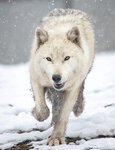Mostly Clear, 26° F
Two gray wolf siblings confiscated by officials from a dodgy roadside “zoo” in Ontario, Canada, are finally in their forever home after a laborious and secretive effort to save the pair …
This item is available in full to subscribers.
The Powell Tribune has expanded its online content. To continue reading, you will need to either log in to your subscriber account, or purchase a subscription.
If you are a current print subscriber, you can set up a free web account by clicking here.
If you already have a web account, but need to reset it, you can do so by clicking here.
If you would like to purchase a subscription click here.
Please log in to continue |
|




Two gray wolf siblings confiscated by officials from a dodgy roadside “zoo” in Ontario, Canada, are finally in their forever home after a laborious and secretive effort to save the pair by officials at the Yellowstone Wildlife Sanctuary in Red Lodge.
Named for iconic peaks in the Beartooth Range, Index (a female) is still a little skittish while Pilot has already made himself home at the certified sanctuary, often perched atop his shelter in the middle of their quarantine enclosure that overlooks the beautiful mountain city. The two “pale” gray wolves, born in captivity and deemed non-releasable, appear white from a distance. They were facing a possible death sentence before the sanctuary agreed to take them, allowing them to live out their lives with “dignity and respect,” said sanctuary Executive Director BR Walker.
“We are the last stop for these animals. They would have been euthanized if we were not able to take them,” she said. “We take very seriously the quality of care — feeding them, medical care, their habitat and being enriched.”
The facility has 34 animals in its care. There are a pair of black bears, bobcats, coyotes, raccoons, a badger, two bison, snakes, lizards and several species of birds — all of which were previously habituated to humans or were found injured in the wild.
However, simply transporting the wolves to Montana was a year-long process necessitating “utmost secrecy” until the required permitting through eight governmental agencies was approved and completed.
“It was so confidential that [the sanctuary] gave the project a code name. Until the agreement was formalized, the board was not even allowed full information. Project ‘Myrtle’ was never mentioned in public or with any reference to species,” Walker said.
The process involved special clearance to cross the Canadian border and traverse the northern U.S. states of Michigan, Minnesota, Wisconsin and North Dakota before arriving at their new home. The sanctuary was required to hire a specialized import broker to manage the complicated bureaucracy.
However, the secret was hard to keep at home while the sanctuary built safeguards in the wolf enclosure to ensure the animals would be secure. The last two wolves that lived at the sanctuary, Ginny and Dakota, escaped for a short time when drifts from heavy snow collected along their fence. The issue was fixed by building a separate enclosure within the large, high-fence pen, but it made folks wonder what was up.
Finally in their new home, Index and Pilot were placed in quarantine for a month to ensure they didn’t bring diseases to the dozens of other wildlife in the sanctuary. The care in their previous roadside zoo was sketchy at best.
Ontario has had a rash of recent crackdowns on private roadside menageries, which have weak or non-existent regulations to keep and monetize wildlife. Often, the care is far from adequate.
“In Ontario, you don’t need expertise, a reason or a license to operate a zoo or buy dangerous animals like a tiger or lion,” said World Animal Protection’s Wildlife Campaign Manager Michèle Hamers in a publicly released statement.
Once an animal is placed at the sanctuary, the staff make a lifetime guarantee to the animals — some of which may live for decades. Yet the sanctuary is different from a zoo in that the enclosures aren’t made for convenient viewing by patrons. Instead it is based on the needs of the animals, part of which is giving them some privacy when they need it, said Animal Care Manager Izzy Sommerdorf.
“It’s important with wildlife to give them a space where they can be hidden. Studies have shown, in facilities like this, that an animal that has an option to hide, even just knowing they have that option makes them more comfortable about being out,” she said.
That said, most of the animals enjoy visitors. In the morning, coyotes yip and howl right next to the wolf enclosure and the raptors and corvids are vocal. The wolves are in quarantine through this week, but Pilot seems to enjoy being close and frequents the fence line next to a paved walk through the facility. He’s playful and loves the snow. From the intimate distance, it’s hard not to look directly into the eyes of these remarkably large predators and feel something wild.
The facility is hoping to soon build indoor facilities for the wolves and a future smaller indoor home for new mountain lions. When finished, the projects will make administering health care to the animals easier and will give them a place to find shelter during periods of bad weather.
The board will apply for permits and hope to start construction soon. But that’s when things get a little complicated. The sanctuary is built on the former Red Lodge landfill. Officials have hired a crew to drill cores to check for areas that are good for the buildings.
About 15 years ago, when Ruth Brown was in charge of the facility and it was called the Beartooth Nature Center, Brown reported to the board that there was a sinkhole near the bison yard. They discovered a 1937 truck, which had been disposed in the landfill, had collapsed after finally rusting through, causing the sinkhole.
One feature of the future buildings which has the entire staff excited is running water. Currently, every bit of water for the animals is carried from the main building to their enclosures in 5-gallon buckets. It makes for some strong arms and sore backs, Walker said.
“When you carry water in 2 to 3 feet of snow to feed an animal, you are a special person,” she said. “Water will be a luxury.”
Walker came on at a difficult time for the sanctuary. First the COVID-19 pandemic made doing business almost impossible. Then the fires and floods that devastated Red Lodge followed.
“With the fire, the floods and COVID, we did a lot of introspection. We had to ask, are we gonna survive? Because all of Red Lodge was hurting,” she said.
They decided giving in wasn’t an option and reaffirmed their lifelong commitments. Their first priority is their wildlife, “their needs are first,” Walker said.
The second priority is education; making sure the sanctuary tells the story about the wild animals in their charge and their habitat in the Greater Yellowstone Ecosystem.
Eden Wondra is the sanctuary’s education manager and creates informative and fun opportunities for members of the public of all ages. They offer summer and winter camps for children, often selling out to local families who return each year.
Powell’s Riley McCallister “loves animals,” and has attended camps both for younger children and for the older kids as he nears his teen years. There are 43 families from Powell who support the sanctuary financially.
Thanks in part to the sanctuary’s educational opportunities, Riley is looking forward to becoming a scientist — possibly a botanist — and working to conserve wildlife habitat when he finishes his education.
His mother, Nicole, said the sanctuary expands on his structured education and has given her son more confidence through attending camps. Riley simply thinks the entire experience is “cool.”
“They help animals and that’s just like a really cool thing we do. And they teach you, like, a lot of really cool stuff. It’s fun,” he said.
The sanctuary is building a culture of care through their education programs.
“Our natural world faces many challenges, and its well-being lies in the hands of upcoming generations. So here at the sanctuary, we take our role in education very seriously,” the sanctuary advertises.
Wondra also does a podcast from the sanctuary headquarters, interviewing scientists and talking shop about caring for wildlife in the Yellowstone Ecosystem.
The public will finally get its first look at the wolves this weekend. The sanctuary opens Friday and Saturday for an exclusive look at Index and Pilot for members, then opens to the general public Sunday. They will be open three days a week through April before returning to their summer hours.
Like all nonprofit organizations, the sanctuary relies on donations. For more information on how to support their efforts: yellowstonewildlifesanctuary.org.
Podcast: yellowstoneecosystem.com.